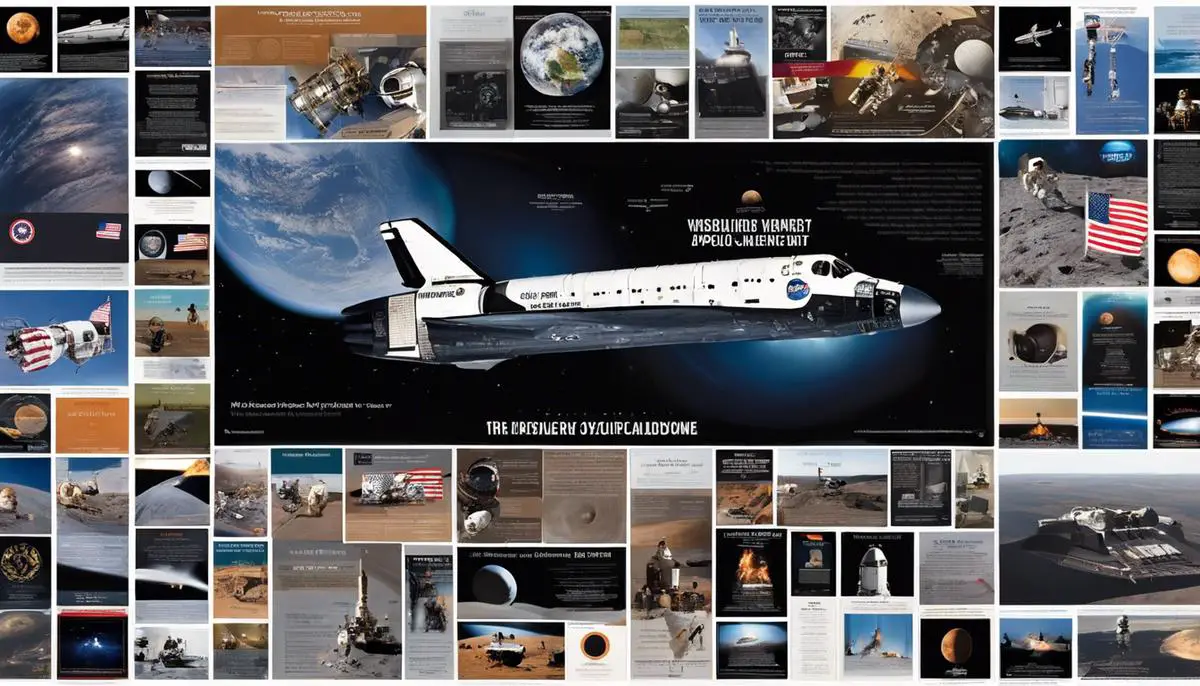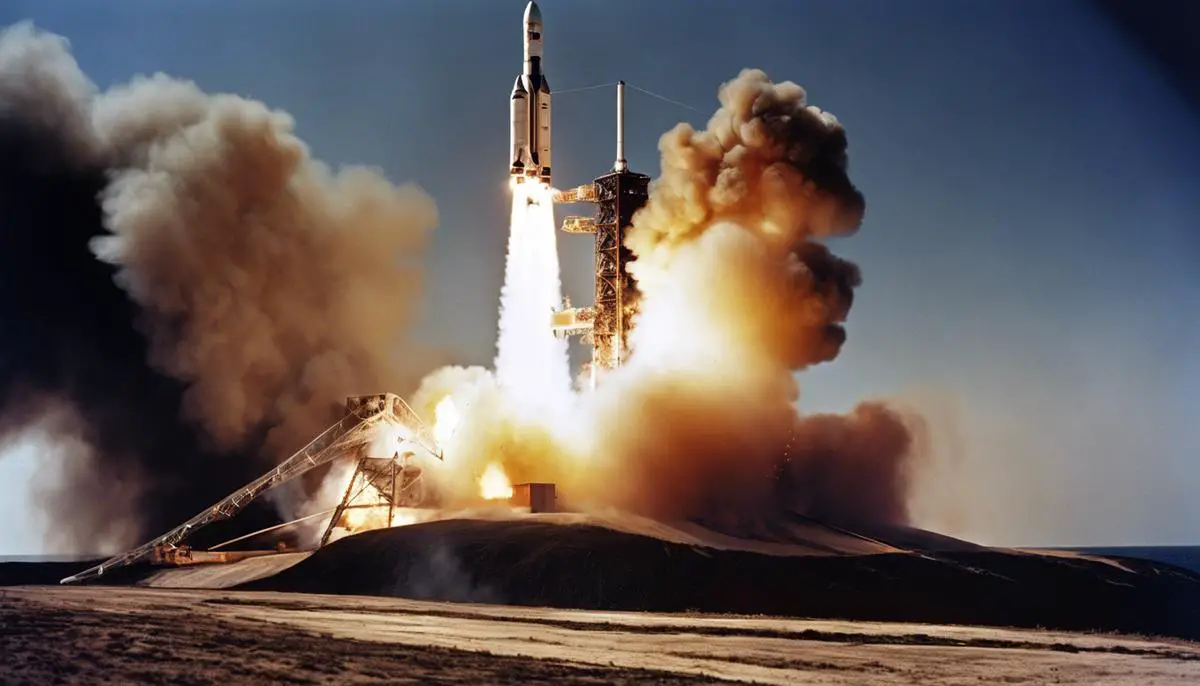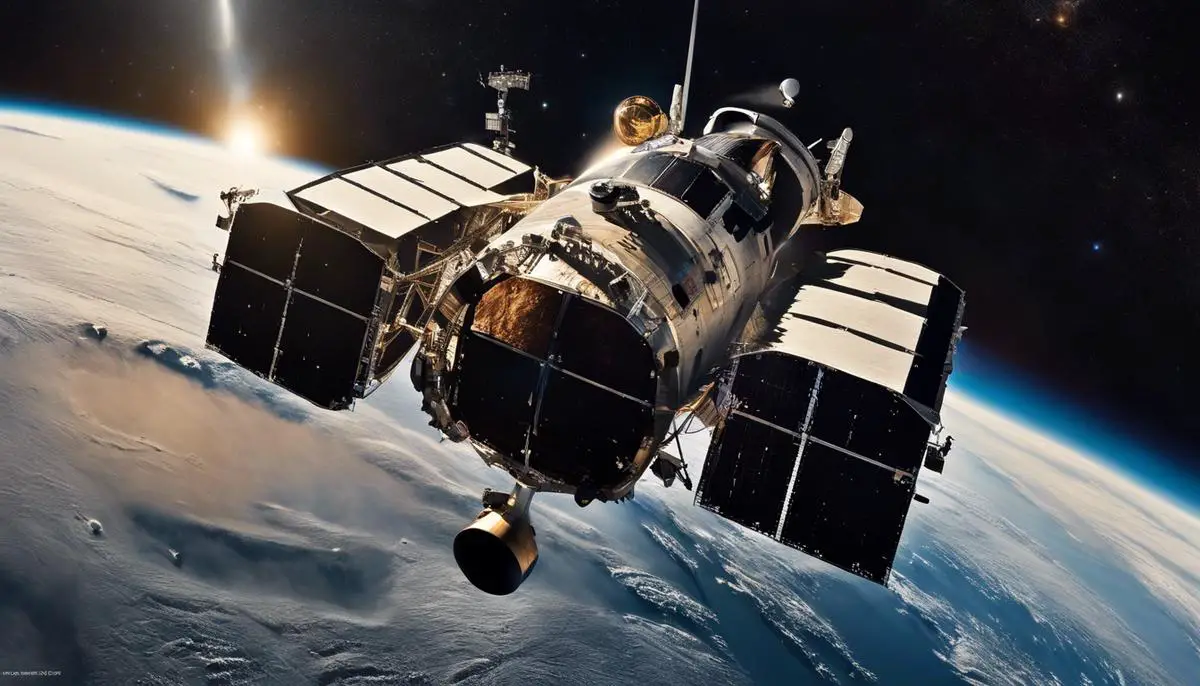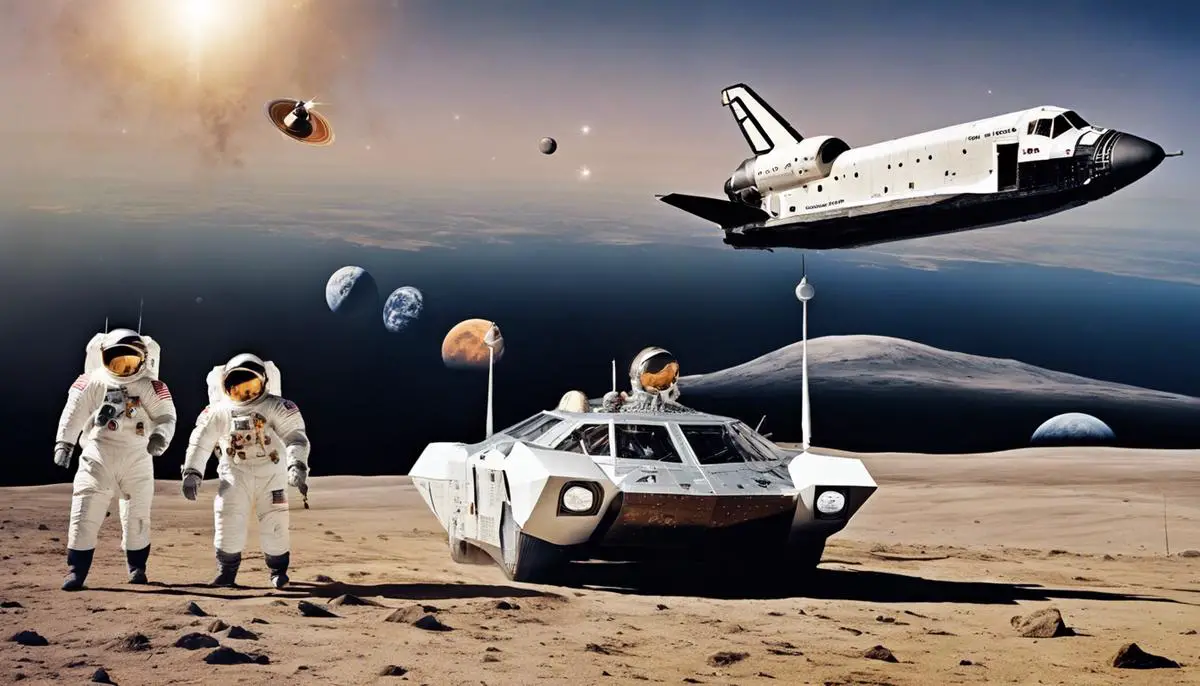When humankind endeavors to conquer the final frontier, it does so with ingenuity, ambition and, sometimes, unimaginable cost. The journey to the stars, symbolized by NASA’s Apollo, Challenger and Columbia missions, grapples not just with technological challenges but also the courage and vulnerability of the explorers and engineers involved. Apollo 1, Challenger and Columbia missions precariously stand as poignant reminders of our attempts and failures in our steep learning curve to grapple with space exploration. Tracing the trajectory of these missions, we examine their technical nuances, societal context and the groundbreaking advances they precipitated – all against the backdrop of their tragic mishaps.
Contents
Overview of Apollo 1, Challenger and Columbia Missions
Unraveling the Historical Context and Mission Objectives of Apollo 1, Challenger and Columbia
A comprehensive understanding of the American spaceflight program necessitates diving deep into the enthralling yet sobering episodes of the Apollo 1, Challenger, and Columbia missions. These adventures into the extra-atmospheric frontiers conferred unprecedented knowledge, but their tragic ends also served as poignant reminders of the inherent risks coupled with the exploration of the unknown.
Firstly, the Apollo 1 mission, initiated in mid-1960s, was heralded as the inception of a new chapter in human space exploration. Its primary aim was to lay the groundwork for the lofty goal of landing a man on the moon. It was an ambitious endeavor incorporated in NASA’s Apollo Lunar Landing Program, intended to validate the design of the command and service module (CSM), while also demonstrating its compatibility with the crew and mission operations.
However, the Apollo 1 mission, originally designated as “AS-204,” met an untimely end during a pre-launch test on January 27, 1967. A fire ignited within the pressurized cabin of the CSM caused the loss of all three crew members, a tragedy that precipitated an in-depth review and significant modifications to the spacecraft’s design and emergency procedures.
Moving onwards to the next pivotal chapter, the Space Shuttle Challenger (STS-51-L), was the tenth flight of NASA’s Space Shuttle program. Launched on January 28, 1986, the primary goal of Challenger’s mission was to deploy the second Tracking and Data Relay Satellite (TDRS-B) and the Spartan Halley spacecraft, a free-flyer intended to study the tail of Halley’s Comet. Additionally, the crew was assigned the task of conducting experiments related to Comet Halley using the Shuttle-Pointed Tool for Astronomy.
Sadly, just 73 seconds into its flight, Challenger broke apart due to the failure of the right solid rocket booster, which led to the disintegration of the external fuel tank and subsequently, the orbiter. This catastrophic incident culminated in the loss of all seven crew members and led to a hiatus in the Space Shuttle program.
The final instance belongs to the Space Shuttle Columbia (STS-107), which carried out a multi-disciplinary, microgravity, and Earth science research mission. Launched on January 16, 2003, Columbia’s aim encapsulated over 80 experiments categorized into areas like astronaut health and safety, advanced technology development, and Earth and space sciences.
On February 1, 2003, Columbia broke apart upon re-entry to the Earth’s atmosphere, causing the death of all seven crew members on board. The incident, traced back to a piece of foam that broke off during launch and damaged the wing of the orbiter, marked another saddening hiatus in the Space Shuttle program and elicited significant procedural and engineering design changes within NASA.
In essence, the history and objectives of the Apollo 1, Challenger, and Columbia missions underscore the indomitable human spirit – an audacious yearning to explore, to learn, and to advance. These endeavors, despite their tragic conclusions, played a fundamental role in pushing the frontiers of our knowledge and shaping the course for future space exploration initiatives. As we reflect on their stories, they stand as solemn testaments to the risks, challenges, and ultimate sacrifices cheek by jowl with the quest for scientific progress.

The Catastrophes: An In-depth Examination
A thorough grasp of the unfortunate incidents associated with Apollo 1, Challenger, and Columbia necessitates a deep comprehension of diverse technical aspects involved in space travel. Such catastrophic failures provide us with invaluable lessons about the perils involved in space missions and how such mishaps can be averted or managed.
Apollo 1’s disaster was fueled by multiple factors. Firstly, the pure oxygen atmosphere, pressurized at a level higher than sea level, transformed the capsule into a potential incendiary bomb. Furthermore, the spacecraft’s interior comprised flammable materials that were susceptible to such an environment. The hatch, notorious for its complicated opening mechanism, furthered escalated this unfortunate circumstance, preventing the astronauts from making an emergency exit. These aspects coalesced to set the stage for a fatal accident.
The Challenger disaster unfolded due to a fatal flaw in its design, concocting a recipe for disaster. The Solid Rocket Boosters (SRBs), integral to initiating the Shuttle’s ascent, were divided into segments sealed with O-rings. The SRBs were designed to withstand certain temperatures, but the cooler ambient conditions on the day of the launch led to these rubber seals becoming rigid and failing to maintain their seal. Hot gases, therefore, streamed past the O-rings, creating a blowtorch-like jet that impinged upon the External Tank, leading to an irreversible catastrophe.
Turning to the Columbia disaster, the culprit was a chunk of foam that had detached from the External Tank during launch. This chunk struck the leading edge of Columbia’s left wing, causing considerable damage. Upon re-entry into the Earth’s atmosphere, the temperatures, reaching up to a few thousand degrees Celsius, infiltrated the wing structure through the damaged area. Subsequently, the hot gases melted the internal structure of the wing, leading to a comprehensive failure and subsequent disintegration of the orbiter.
Post these tragic events, NASA underwent significant changes in its operations and design philosophies. The Apollo block II was significantly overhauled, with a less hazardous gas mix, fire-resistant materials, a refined wiring layout, and a hatch that could be opened in seconds. Post-Challenger, a significant redesign of the SRBs was undertaken, ensuring that the joint would completely seal, regardless of temperature or other conditions. After Columbia, new techniques for in-orbit inspection and repair were developed, which are in effect to this day in the operations of the International Space Station.
These missions, albeit tragically unsuccessful, have profoundly redirected the course of space exploration. Alterations prompted by these disasters have shaped modern spaceships into safer, more reliable vessels. They quietly whisper the unforgiving nature of space and remind us of the need for meticulous attention to detail, stringent safety protocols, and comprehensive testing. Experience captained by tragedy has consistently mothered significant advancements in the realm of aeronautics. It’s an unsparing reminder of the supreme price that may accompany human progress and the passionate pursuit of knowledge.

The Aftermath: Changes to Safety and Practice
In the realm of space exploration, these major incidents: Apollo 1, Challenger and Columbia initiated a cascade of transformational shifts in safety measures, procedures, and practices applied to the design, testing, and operation of spacecraft. Harnessing the harshest lessons from these tragedies, the approach to risk assessment, management, and mitigation within NASA and the space industry evolved substantially.
The regrettable accident involving Apollo 1 unveiled the critical necessity of comprehensive safety measures in spacecraft construction and testing. Building upon the harsh lessons learned from the incident, the Apollo spacecraft became subject to precious modifications. A leading transformation pertained to the replacement of the pure-oxygen atmosphere in the cabin during ground tests through the implementation of a two-gas system. Moreover, the arduous redesign of the command module hatch emerged pivotal, with rapid-open hatches now a staple in modern spacecraft, permitting far swifter evacuation if required. Even circuitry and plumbing underwent numerous amendments, all instituting the central doctrine of redundancy and fail-safe designs in the heart of spaceflight engineering.
Similarly, the tragedy of the Challenger Mission prompted key changes in the design and management of solid rocket boosters. The recognition of an inherent fault in the O-rings led to the immediate rectification of the design and the implementation of more stringent pre-launch inspection procedures. Bringing forth the sober realization of the heavy consequences attached to disregarded risk warnings, the Challenger accident ignited a profound enhancement of safety culture within NASA, leading to the establishment of the Office of Safety, Reliability, Maintainability, and Quality Assurance.
The lamentable loss of Columbia importantly demonstrated the criticality of exhaustive pre-flight inspections and ongoing mission risk assessments. As a result of the accident investigation, greater emphasis was placed on the regular inspection of the Thermal Protection System of the orbiter, the necessity of in-orbit repair capabilities, and real-time damage assessment strategies. The lessons culled from Columbia’s unfortunate end significantly influenced later spacecraft designs and procedures, notably contributing to the abundant safety provisions enclosed within the Orion Spacecraft.
In summation, these incidents have tragically yet indispensably underscored the constant requirement of close vigilance, meticulous planning, and never-ceasing improvements in the field of space exploration. They instigated enhanced safety protocols, design improvements, and a more conscious operation culture within NASA and beyond. Despite the heavy tragedies they carried, these incidents paved the way for safer, better-prepared, and more efficient future missions. The aphoristic wisdom – failure is the precursor to success, remains apt in the continually evolving realm of space exploration and human efforts to map the cosmos.

Scientific Discoveries and Technological Advancements
The fiery demise of Apollo 1 and its crew served as a grim reminder of the dangers encountered in venturing into the uncharted territories of space. This tragic incident did not end in vain, though, as it sparked some significant improvements in spacecraft safety. Post-incident investigations pinpointed the spacecraft’s atmosphere of pure oxygen as a critical factor that contributed to the rapid spread of the fire. This led to introducing a mixed-gas environment in all subsequent command modules, which significantly reduced flammability. This significant shift in standard procedure echoed far beyond the walls of NASA and became pivotal in setting safety standards on a global scale for all manned space missions.
Moreover, the Apollo 1 tragedy highlighted the need for a rapid, reliable escape route. The inward-opening and complex to operate hatch that unfortunately secured the fate of the crew was subsequently replaced with a quick-release, outward-opening model. This change was instrumental in making future space missions safer, highlighting the unforgiving but lasting lessons from Apollo 1.
Moving into the era of Space Shuttle Program, the egregious loss of Challenger, 73 seconds after liftoff, pointed the scientific community towards an inherent design flaw —the properties and operational limitations of certain materials under varying conditions. The rubbery O-rings sealing the joints of the Solid Rocket Boosters, which failed in the cold, has since then become textbook material for engineering courses worldwide —a somber example of overlook turning fatal. Besides prompting a redesign of Solid Rocket Boosters, this incident also led to the creation of the critical position of ‘Chief Engineer,’ responsible for independently verifying a spacecraft’s readiness for launch and the formation of independent oversight panels for reviewing critical procedures and decisions.
On the other hand, the disintegration of Columbia triggered a thorough reassessment of the newly established “Faster, Better, Cheaper” approach at NASA. The incident showed that cutting costs in one area might lead to catastrophic expenses in another, ultimately questioning the values that were being prioritized at the time. This incident underlined the importance of diligent pre-flight inspections, particularly regarding the Thermal Protection System. Subsequent missions saw the addition of comprehensive inspection of this system prior to launch and the development of techniques to perform in-orbit, if required.
Another major influence of the Columbia incident was the advancement of technology for damage detection and repair in orbital conditions. A new breed of inspection and repair instruments was developed and ultimately tested in subsequent missions, proving their effectiveness and paving the way for future spaceflight safety.
These astronauts’ sacrifice has etched their names indelibly in the annals of spaceflight. Their loss has become the cornerstone upon which much of the existing safety guidelines, procedures, and failsafe mechanisms are centered. These tragedies have thus also become the building blocks of advancements in technology and processes that continue to shape the future of space exploration, farther and deeper into the cosmos. As the French author Andre Gide rightly said, “One doesn’t discover new lands without consenting to lose sight of the shore for a very long time.” The arduous journey of exploration is fraught with perils and losses; however, these losses reaffirm the commitment to safer and more effective space exploration for the generations to come.

Legacy: Impact on Future Missions
Despite having covered numerous aspects related to these pivotal incidents in space history, it remains vital to highlight the enduring societal and scientific impact that Apollo 1, Challenger, and Columbia missions continue to exert on space exploration. These transformative events not only reshaped our understanding of space as a frontier but also redefined our collective striving towards that frontier.
The post-Apollo 1 reforms navigated the path to the success of further Apollo missions. In the wake of Apollo 1 catastrophe, the scientific community galvanized, leading to the monumental Apollo 11 mission that resulted in the first manned moon landing. This iconic expedition would continue to serve as a beacon of mankind’s ability to overcome barriers, persisting as a source of collective inspiration and spurring global interest and collaboration in space exploration.
Furthermore, the lessons learned from the shocking Challenger disaster resulted in a renewed focus on crew safety, culminating in an institutional shift within NASA. From the ashes of the disaster rose a heightened commitment to detailed pre-flight checks and the rigorous documentation of potential risks. These improvements in safety procedures and standards were instrumental in subsequent successful missions, effectively paving the way for major and internationally collaborative projects such as the International Space Station.
Similarly, the Columbia tragedy and its subsequent investigation led to a necessary reevaluation of NASA’s organizational culture and communication structures. This reform encouraged a more open flow of information and improved decision-making processes. Consequently, this has favored a less hierarchical culture, promoting individual responsibility and pushing our exploratory capacities forward. The new age of commercial space exploration, marked by entities such as SpaceX and Blue Origin, is imbued with these values of open communication and safety-first principles.
These missions and their tragic ends have also stressed the importance of incorporating a robust system of checks and balances in decision-making processes related to mission safety. Enhanced astronaut training programs, improved vehicle design, and risk assessment strategies have since become central to contemporary spaceflight operational plans.
Last but not least, the public response to these events signifies the human connection to space exploration. The global mourning in response to these tragedies, the subsequent prayers for the deceased astronauts, and the outpouring support for their families reflect the depth of collective empathy and shared investment. These missions have indeed humanized space exploration, reminding us that beyond the cold, calculating, and analytical core of scientific endeavor, beats a human heart.
While these unfortunate incidents have marked significant setbacks, they also represent milestones in resiliency, serving as stark reminders of the inherent dangers of space exploration. The lessons learned from Apollo 1, Challenger, and Columbia have been monumental in furthering our efforts in not only exploring but existing in space. Their legacy endures in every precaution taken, every safety check conducted, and every successful launch and mission completed.
While the focus of space exploration might have pivoted, it has unequivocally not diminished. The spirit of unyielding inquiry, animated by a constellation of past experiences continues to fuel our endeavors. The legacy of Apollo 1, Challenger, and Columbia is etched into every subsequent leap we take into the cosmos, an enduring testament to the resilience and tenacity of the human spirit.

As we revel in the awe-inspiring spectacle of the cosmos, it’s prudent to pause and reflect upon the legacy of the ill-fated Apollo 1, Challenger and Columbia missions. Infused into the fabric of space exploration, they embody the spirit of human resilience and innovation in the face of catastrophic failure. It is through revisiting these significant events that we gain a profound understanding of our past, our achievements and mistakes and use them as signposts for our forthcoming journeys into the cosmos. The echoes of these tragic missions resonate in every cautious step we take towards our future – towards Mars and beyond, shaping the roadmap for our ongoing endeavors and ensuring their sacrifices were not in vain.
